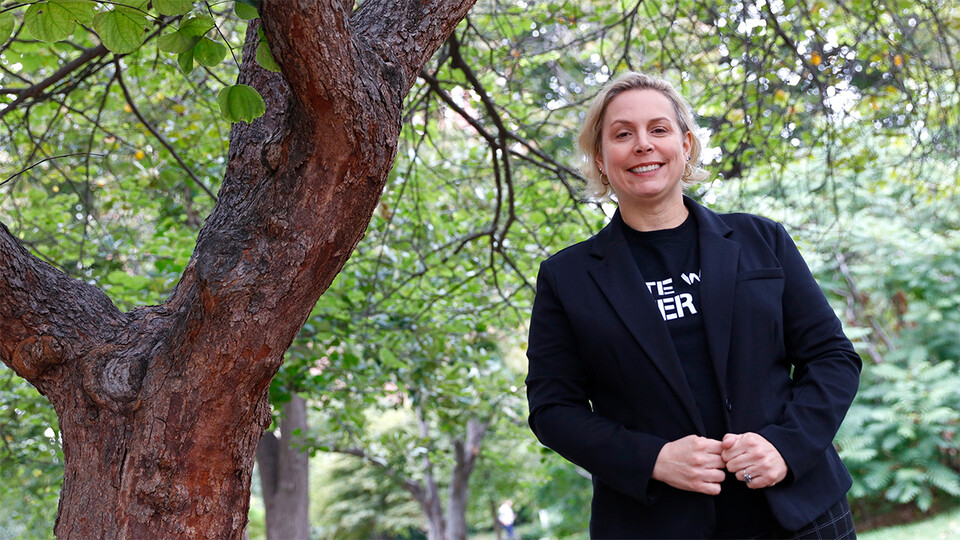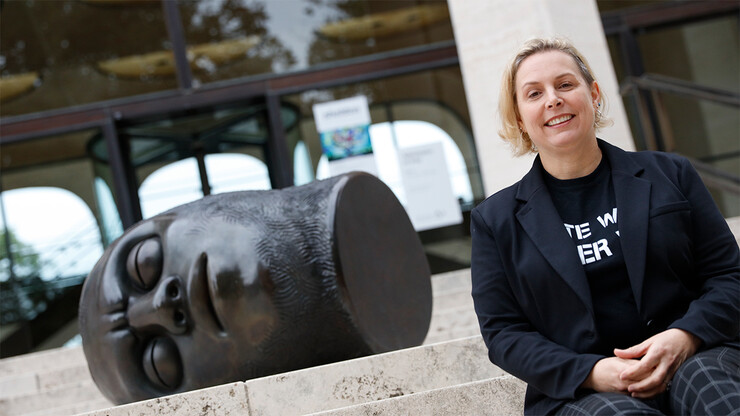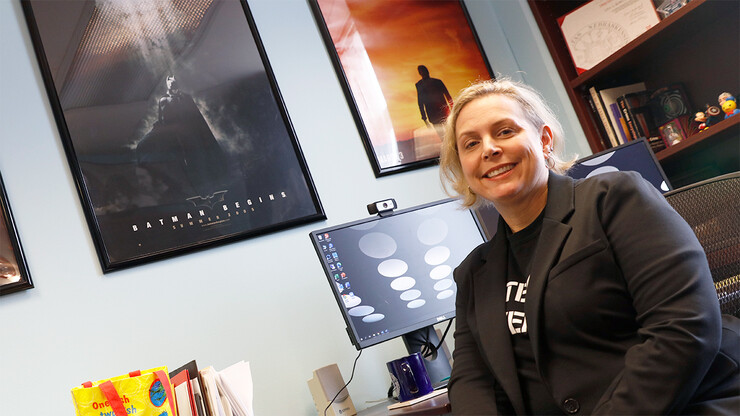· 9 min read
Rust Belt to Corn Belt: Kort-Butler celebrating 15 years as Husker

Perched on the seventh floor of the towering Oldfather Hall, the office of Lisa Kort-Butler doesn’t mark her as a sociologist so much as an unabashed nerd.
Framed movie posters line the walls. There’s what could be called the Superhero Wing, where Wonder Woman and Batman and Wolverine strike stark-lit poses laden with the ambiance of the comics that spawned them. On the opposite wall, The Beatles gaze over a miniature replica of Captain America’s shield at a boyish Anakin Skywalker and Bruce Lee’s son, Brandon, predestined legends shouldering burdens of expectation. Kermit the Frog and Mickey Mouse boast pride of place on bookshelves.
A closer look, though, reveals the telltales of a scholar’s hideout. Volumes of the academic journal Criminology & Public Policy crowd tomes detailing the finer points of juvenile delinquency, data analysis and fear’s effects on the brain. A copy of “The Pornography Wars,” by fellow Husker sociologist Kelsy Burke, rests on her desk.
Since joining the University of Nebraska–Lincoln, Kort-Butler has made space for both the pop-cultural and the sociocultural in her office, her research and her teaching. In that way, Kort-Butler’s career almost seems to personify her field — the culmination of a Trekkie band geek growing up in the 1990s, when spiking crime rates led newscasts, content warnings permeated the TV and music industries, and panics erupted over rap and Mortal Kombat.
“I was curious about how the world operated,” said Kort-Butler, who will mark her 15th anniversary with Nebraska U at the annual Celebration of Service on Sept. 28. “And in the early ’90s, as a teenager, there was a lot of emphasis on crime and young people being involved in it. It was in the news a lot, and it was statistically at a peak.
“I didn’t know it at the time, but as I left high school and went to college, those are the kinds of things that I think were stewing in my head.”
That stew simmered at Bowling Green State University, where she graduated summa cum laude in sociology and psychology, then the University of Akron, for her master’s, and finally North Carolina State University, where Kort-Butler earned her doctorate. She was very much a creature of the Rust Belt and East Coast. But in her search for a faculty job, a friend and former Husker put Nebraska — a state she’d only ever seen on her way to somewhere else — on her radar.
“This seemed further afield than I had imagined going with my life,” she said of the Cornhusker State. “All our family is back east.
“I didn’t have a sense of what we’re all about out here.”
She prepared herself for farms, which were nothing new to her, but was surprised to encounter none on her initial visit to Lincoln in November 2006. The chill of a late autumn was familiar, too, if not the fierceness of the winds that swept through City Campus. Still, the city offered more culture, while enveloped by more of the exploration-worthy great outdoors, than she expected.
“The few days that I was here for the interview,” Kort-Butler said, “it became a place that I could envision myself being.”
Born outside Pittsburgh to a family of Steelers fans, then transplanted to the football-crazed state of Ohio, the newly hired assistant professor of sociology took quickly to the culture of fall Saturdays in Lincoln. Kort-Butler grew up near Canton, home to the Pro Football Hall of Fame, where annual weeklong parades took over downtown and drew thousands of fans to celebrate legends of the gridiron. The years spent toiling away on a Ph.D. in North Carolina, meanwhile, had introduced her to the madness of college sports via Tobacco Road and ACC basketball.
“In that sense, I understand fandom. I get it,” she said. “But Husker fandom, it’s not something that I had ever quite experienced. People tried to tell me, right? But the way that the spirit of it all encapsulates not just the whole town but the whole state… We joked in our family, initially, that we wouldn’t wear red on Saturdays, because we couldn’t find each other in the store.”
Just a Hail Mary’s throw from Memorial Stadium, at Oldfather Hall, Kort-Butler was already developing a reputation as a favorite among her students. In 2008, a year after her arrival, the Kappa Alpha Theta Sorority recognized Kort-Butler as an Outstanding Professor. The College of Arts and Sciences would later twice bestow her with its Distinguished Teaching Award.
It probably helps, she figures, that she embraces another signature of the Midwest: “I’m sort of self-effacing,” she said, going on to explain how much more innovative her colleagues are in the classroom. But when Kort-Butler walks into a class, she said, energy tags along. She’s hand-talking. She’s roaming around the classroom, listening in on group discussions among her students.
“Teaching is performance,” she said, a lesson that the pandemic-driven transition to remote teaching only reinforced for her. “That old band geek in me comes back, like, ‘We’re doing a show now!’
“You should be tired after teaching. It’s like being on stage: You’re done, the performance is over, now you’ve got to unwind.”
If most of her instruction takes place in Oldfather, Kort-Butler’s favorite teaching exercise unfolds at another, wholly unexpected site. Every year, Kort-Butler leads her classes on possibly the world’s shortest field trip, making the thousand-step trek from the university’s seat of sociology to its Sheldon Museum of Art.
Much of Kort-Butler’s research, and some of her teaching, centers on the intersection of health and society. In one course, she assigned reading on how certain medical schools incorporate curriculum from the humanities “to poke that side of their students’ brains, to essentially humanize patients and health care.” Inspired, she took her own class to the Sheldon with a question in tow: If you were putting on an art show at a hospital, which pieces would you pick?
And when teaching the theory-heavy portion of a class on delinquency, Kort-Butler has students wander the museum and snap photos before ultimately deciding which artworks best illustrate theoretical concepts.
“It makes the brain work in ways that they might not be accustomed to,” she said. “But a lot of students never go over there.
“So it also ends up being my sly way of saying, ‘Hey, look how fun art is.’ I’m not an artist by any means, but I think it’s the pop culture side of me that’s like, ‘Look at all the visual things in our world that tell stories.’”
It wasn’t long before that side was finding its way into Kort-Butler’s research. She was initially inspired by a book on the mythology of crime — the way that media, from news and film to TV and podcasting, “tells us a story about what crime is.” Working with the university’s Bureau of Sociological Research, Kort-Butler would soon embed questions about the consumption of crime-related media in the Nebraska Annual Social Indicators Survey, then analyze relationships between those media habits and the public’s views on the death penalty.
She was finding inspiration in the personal, too. Once, while at home, her oldest son had paused an episode of “Batman: The Animated Series” when Kort-Butler walked into the room.
“I said to him, ‘Hey, what’s happening on the show?’ And he said, ‘That’s a bad guy.’ It wasn’t one of the (primary) villains; it was just a generic guy. It got me thinking: How does he know that? What is happening in the storyline and the portrayal of this — the music, the styling — that he knows this is a bad guy?
“It turns out, not a lot of people had actually asked that question about kids’ shows, especially as it pertained to crime.”
Kort-Butler’s pursuit of answers yielded the 2013 study “Justice League? Depictions of Justice in Children’s Superhero Cartoons,” which itself generated coverage from outlets that included USA Today. In 2021, she examined how various Batman-centric animated shows have tied the brain to deviance and criminality.
“How is this crafting narratives and potentially counter-narratives about what crime is, who does it, how we administer justice — all of these questions,” she said. “They’re newer (questions) in terms of thinking about kids’ animation, but they’re not new in terms of things like fairy tales. We’ve done morality tale-telling forever. Those stories help us understand the world and communicate what our society thinks we should do about problems in the world.”
Her research, teaching and administrative efforts propelled Kort-Butler to tenure, and the title of associate professor, in 2014. Two years ago, she took on the role of vice chair in the Department of Sociology, and earlier this year, she was promoted again, this time to full professor. Combined with the retirement of faculty she came to see as mentors, Kort-Butler said her experience and added responsibilities have naturally lent a greater sense of ownership over the department than she felt as a junior faculty member.
“But it doesn’t feel like I’ve been here a long time,” she said.
Back when she was an undergrad at Bowling Green, she once wondered why a particular faculty member would have bothered to stick around one place for 40 years. Now? She gets it.
“I think the people here are great,” she said. “My colleagues do amazing, amazing things all the time, and I get to go along for the ride. That’s how I feel about it. I’m just along for this ride.
“Every day, I am glad that I work here. I get my coffee at the library, I walk over to Oldfather, and every day, I’m like, ‘This is a great experience.’”










